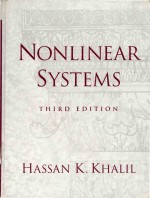图书介绍
Nonlinear Systems Third Editionpdf电子书版本下载

- Hassan K. Khalil 著
- 出版社: Prentice Hall
- ISBN:0130673897
- 出版时间:2002
- 标注页数:750页
- 文件大小:76MB
- 文件页数:771页
- 主题词:
PDF下载
下载说明
Nonlinear Systems Third EditionPDF格式电子书版下载
下载的文件为RAR压缩包。需要使用解压软件进行解压得到PDF格式图书。建议使用BT下载工具Free Download Manager进行下载,简称FDM(免费,没有广告,支持多平台)。本站资源全部打包为BT种子。所以需要使用专业的BT下载软件进行下载。如 BitComet qBittorrent uTorrent等BT下载工具。迅雷目前由于本站不是热门资源。不推荐使用!后期资源热门了。安装了迅雷也可以迅雷进行下载!
(文件页数 要大于 标注页数,上中下等多册电子书除外)
注意:本站所有压缩包均有解压码: 点击下载压缩包解压工具
图书目录
1 Introduction 1
1.1 Nonlinear Models and Nonlinear Phenomena 1
1.2 Examples 5
1.2.1 Pendulum Equation 5
1.2.2 Tunnel-Diode Circuit 6
1.2.3 Mass-Spring System 8
1.2.4 Negative-Resistance Oscillator 11
1.2.5 Artificial Neural Network 14
1.2.6 Adaptive Control 16
1.2.7 Common Nonlinearities 18
1.3 Exercises 24
2 Second-Order Systems 35
2.1 Qualitative Behavior of Linear Systems 37
2.2 Multiple Equilibria 46
2.3 Qualitative Behavior Near Equilibrium Points 51
2.4 Limit Cycles 54
2.5 Numerical Construction of Phase Portraits 59
2.6 Existence of Periodic Orbits 61
2.7 Bifurcation 69
2.8 Exercises 76
3 Fundamental Properties 87
3.1 Existence and Uniqueness 88
3.2 Continuous Dependence on Initial Conditions and Parameters 95
3.3 Differentiability of Solutions and Sensitivity Equations 99
3.4 Comparison Principle 102
3.5 Exercises 105
4 Lyapunov Stability 111
4.1 Autonomous Systems 112
4.2 The Invariance Principle 126
4.3 Linear Systems and Linearization 133
4.4 Comparison Functions 144
4.5 Nonautonomous Systems 147
4.6 Linear Time-Varying Systems and Linearization 156
4.7 Converse Theorems 162
4.8 Boundedness and Ultimate Boundedness 168
4.9 Input-to-State Stability 174
4.10 Exercises 181
5 Input-Output Stability 195
5.1 L Stability 195
5.2 L Stability of State Models 201
5.3 L2 Gain 209
5.4 Feedback Systems:The Small-Gain Theorem 217
5.5 Exercises 222
6 Passivity 227
6.1 Memoryless Functions 228
6.2 State Models 233
6.3 Positive Real Transfer Functions 237
6.4 L2 and Lyapunov Stability 241
6.5 Feedback Systems:Passivity Theorems 245
6.6 Exercises 259
7 Frequency Domain Analysis of Feedback Systems 263
7.1 Absolute Stability 264
7.1.1 Circle Criterion 265
7.1.2 Popov Criterion 275
7.2 The Describing Function Method 280
7.3 Exercises 296
8 Advanced Stability Analysis 303
8.1 The Center Manifold Theorem 303
8.2 Region of Attraction 312
8.3 Invariance-like Theorems 322
8.4 Stability of Periodic Solutions 329
8.5 Exercises 334
9 Stability of Perturbed Systems 339
9.1 Vanishing Perturbation 340
9.2 Nonvanishing Perturbation 346
9.3 Comparison Method 350
9.4 Continuity of Solutions on the Infinite Interval 355
9.5 Interconnected Systems 358
9.6 Slowly Varying Systems 365
9.7 Exercises 372
10 Perturbation Theory and Averaging 381
10.1 The Perturbation Method 382
10.2 Perturbation on the Infinite Interval 393
10.3 Periodic Perturbation of Autonomous Systems 397
10.4 Averaging 402
10.5 Weakly Nonlinear Second-Order Oscillators 411
10.6 General Averaging 413
10.7 Exercises 419
11 Singular Perturbations 423
11.1 The Standard Singular Perturbation Model 424
11.2 Time-Scale Properties of the Standard Model 430
11.3 Singular Perturbation on the Infinite Interval 439
11.4 Slow and Fast Manifolds 443
11.5 Stability Analysis 449
11.6 Exercises 460
12 Feedback Control 469
12.1 Control Problems 469
12.2 Stabilization via Linearization 475
12.3 Integral Control 478
12.4 Integral Control via Linearization 481
12.5 Gain Scheduling 485
12.6 Exercises 499
13 Feedback Linearization 505
13.1 Motivation 505
13.2 Input-Output Linearization 509
13.3 Full-State Linearization 521
13.4 State Feedback Control 530
13.4.1 Stabilization 530
13.4.2 Tracking 540
13.5 Exercises 544
14 Nonlinear Design Tools 551
14.1 Sliding Mode Control 552
14.1.1 Motivating Example 552
14.1.2 Stabilization 563
14.1.3 Tracking 572
14.1.4 Regulation via Integral Control 575
14.2 Lyapunov Redesign 579
14.2.1 Stabilization 579
14.2.2 Nonlinear Damping 588
14.3 Backstepping 589
14.4 Passivity-Based Control 604
14.5 High-Gain Observers 610
14.5.1 Motivating Example 612
14.5.2 Stabilization 619
14.5.3 Regulation via Integral Control 623
14.6 Exercises 625
A Mathematical Review 647
B Contraction Mapping 653
C Proofs 657
C.1 Proof of Theorems 3.1 and 3.2 657
C.2 Proof of Lemma 3.4 659
C.3 Proof of Lemma 4.1 661
C.4 Proof of Lemma 4.3 662
C.5 Proof of Lemma 4.4 662
C.6 Proof of Lemma 4.5 663
C.7 Proof of Theorem 4.16 665
C.8 Proof of Theorem 4.17 669
C.9 Proof of Theorem 4.18 675
C.10 Proof of Theorem 5.4 676
C.11 Proof of Lemma 6.1 677
C.12 Proof of Lemma 6.2 680
C.13 Proof of Lemma 7.1 684
C.14 Proof of Theorem 7.4 688
C.15 Proof of Theorems 8.1 and 8.3 690
C.16 Proof of Lemma 8.1 699
C.17 Proof of Theorem 11.1 700
C.18 Proof of Theorem 11.2 706
C.19 Proof of Theorem 12.1 708
C.20 Proof of Theorem 12.2 709
C.21 Proof of Theorem 13.1 710
C.22 Proof of Theorem 13.2 712
C.23 Proof of Theorem 14.6 713
Note and References 719
Bibliography 724
Symbols 740
Index 742
精品推荐
- Northanger Abbey(1818)
- Emma(1815)
- Sense And Sensibility(1811)
- Mansfield Park(1814)
- HUMANITIES THE EVOLUTION OF VALUES
- Pride And Drejudice(1812)
- English
- 企鹅经济学词典 经济学
- 大人的友情 河合隼雄谈友谊
- Computing Concepts
- Advanced Compilpr Design and lmplementation
- 中国商事法律要览
- Introduction to polymers
- CONFICT OF LAWS IN THE WESTERN SOCIALIST AND DEVELOPING COUNTRIES
- Measurement and Research Methods in International Marketing